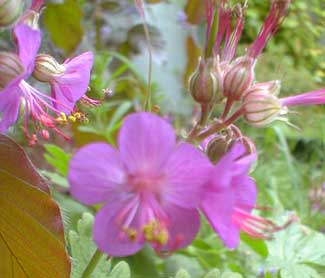
Ingwersen's Bigroot
or Bigfoot Geranium
"The pugilist lounged by the window & let loose
at intervals a raucous laugh that startled
even the geraniums."
-Naomi White,
1937
1937
'Ingwersen's Variety' of Geranium macrorrhizum is named for the Danish/German plantsman Walter Ingwersen, author of The Genus Geranium (1946). His name also appears on cultivars of saxifraga & heather. With his son Will Ingwersen he was a well-famed developer of alpine perennials & other extremely hardy flowers.
He opened his first nursery in London early in the 20th Century & it thrived until the first world war put an end to it. During the war he cared for the Royal Horticultural Society Garden at Wisley in Surrey, then opened his Six Hills Nursery first in Stevenage then in Letchworth.
In 1927 he founded his fourth & most famous nursery, Birch Farm, consisting of several acres & an Elizabethan farmhouse in Sussex.
The bigroot crane's-bill variety that bares his name is a recipient of the Award of Garden Merit. The clump produces soft pale lavender flowers with elaborately showy pistils & stamins.
The reason it is called Bigroot Geranium is because it has the thickest most tubrous root of any crane's-bill, & this enormous fat root stores water so that the clump does not wither through droughty times.
The unusually large rhizomes over time can rise out of the ground like a woody winding nub. I find the rhizomes so interesting that it is appealing to observe the plant even when dormant or trimmed back in winter.
Ingwersen's Bigroot remains fluffy & attractive spring through autumn even in terrible conditions. Though it will tolerate light shade & occasional dryness, it really wants a great deal of sun & persistent moisture. I really pushed the limits of its tolerance of dry shade by placing it underneath a Western Mock Orange (Philadelphus lewisii gordianus) in a spot under the eaves where it got got blessed little sun & was greatly sheltered from rainfall. Even in this horrid spot, it thrived as green foliage, but never bloomed & did not exhibit its capacity to spread.
Other crane's-bills would've been so stressed in that dry shady place they wouldn't even have nice leaves, but would dry up & die. I had really hoped the Bigroot would fill in a difficult area with greenery plus trail its leaves far enough out into better light to perform at least moderately with flowers.
Tired of seeing no flowers at all, after two or three years, I moved it to a spot that got good rainfall & watering, still a mite shaded part of the year, but not excessively so, just inside the dripline of a loosely-limbed 'Black Swan' Beech. By spring after it was moved, it had really livened up. It's one of the first crane's-bills to have a big mound of fresh foliage at winter's end, then blooms before April's end & through May. As its blossoms are petering out, other crane's-bills growing nearby are entering their fullest flower.
Besides tolerating more dryness than most crane's-bills, G. macrorrhizum is additionally more heat-hardy than most. Without regular watering it may have partial die-back in summer, but it'll recover in autumn before experiencing full winter dormancy.
'Ingwersen's Variety' is a select form of the wild species, not a registered cultivar. Native especially of the Balkans & Carpathians, 'Ingwersen's Variety' was first collected near Montenegro. It has lighter green leaves & a softer subtler shade of lavender-pink than other varieties of this species which tend to be a dark purple-violet. We have a variegated cultivar of the same species, G. macrorrhizum 'Variegatum' which is comparatively weaker in the garden, though still a pretty tough plant.
On average Ingwersen's crane's-bill grows to a foot in height & two foot width, but an old clump can be quite a bit bigger than that, to two feet high & four feet wide. The leaves are larger than most crane's-bills, four inches commonly, eight inch leaves occasionally. The leaves are furry (another feature of drought-tolerant plants) & have a very spicy odor when handled, bruised, or rustled by the wind.
In autumn the leaves have splendid coloration. The enormity of the leaves & the density of the roots means no weeds can grow around it, but also smaller plants should be placed away from its smothering leaves. Many species of crane's-bills make nice groundcovers through which stems from flowering bulbs arise, & then when the bulbs are dying back, the crane's-bills remain to give the area life; but Bigroot is difficult to used in that manner.
Whatever of the leaves survives winter will look quite tawdry before the arrival of spring. The old leaves should all be trimmed to within three our four inches of the ground, or to the nubby root, in January or February. This will hasten early spring regrowth.
It does not often call for division, although if it gets too big, a shovel can slice off a side of it to plant elsewhere.